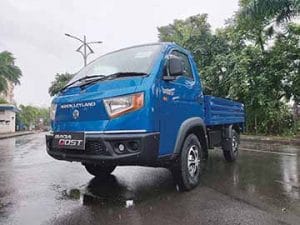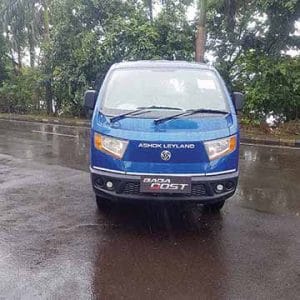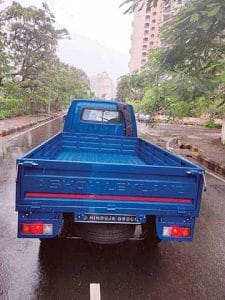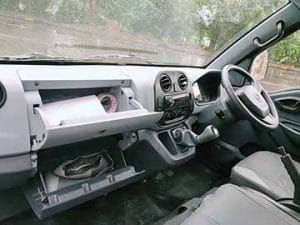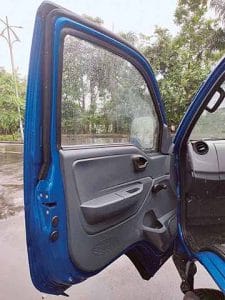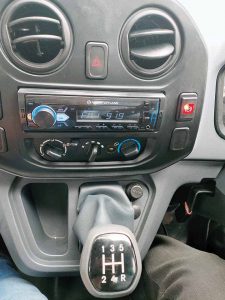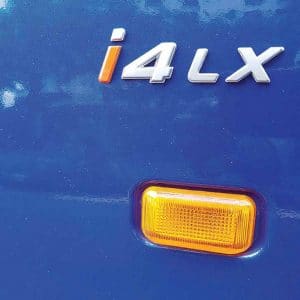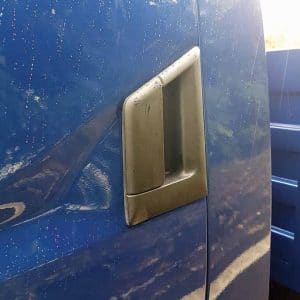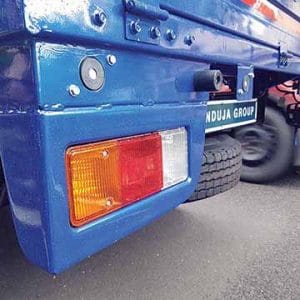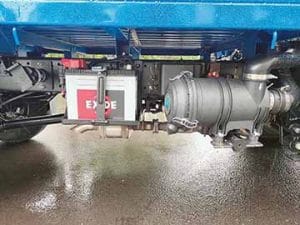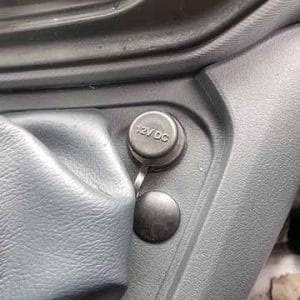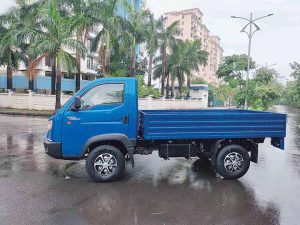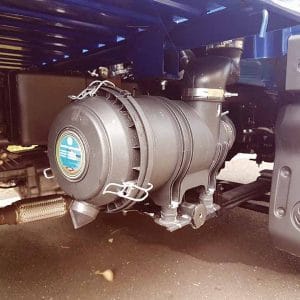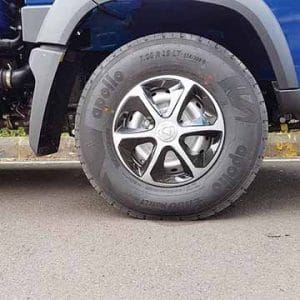‘Bada Dost’ marks a significant shift at Ashok Leyland with global aspirations to boast of.
Story by Bhushan Mhapralkar
Nearly a decade after the Dost LCV was launched in association with Nissan, Ashok Leyland has introduced an all-new LCV called the ‘Bada Dost’. As the name would suggest, the new vehicle builds on the legacy of the ‘Dost’, but is keen to chart its own route. With the pictures failing to do justice to its appearance and dimensions, the ‘Bada Dost’ is indeed quite ‘Bada’ or bigger than the ‘Dost’. It is in flesh that the visual expanse of the ‘Bada Dost’ is apparent. Wider (1750 to 1842 mm), taller (2061 to 2037 mm) and longer (5025 mm) than the Dost, the rounded ‘grille-less front profile of the ‘Bada Dost’ with those ‘Dost’-like (albeit bigger) head lamps makes a solid impression. An Ashok Leyland’s IPR product compared to ‘Dost’s’ IPR, which has certain limitations since it includes Nissan association, the ‘Bada Dost’ picks up from where the ‘Dost’ and ‘Dost+’ leave. There is a slight overlap when one considers the ‘Dost+’ and the 2.9-tonne GVW variant (with a 1460 kg payload) of the ‘Bada Dost’. However, beyond that there is little that is there to consider. The ‘Bada Dost’, as Nitin Seth, the chief operating officer of Ashok Leyland would like to put it, is all-new.
Blurring the gap between the segment that the Tata Intra, and the Mahindra Bolero is in, the ‘Bada Dost’ may point at a similar strategy that Ashok Leyland deployed when it introduced the ‘Dost’ in 2011. Seth however is of the opinion that the market placement of the ‘Bada Dost’ is based entirely on the market requirement. With nary a component except the engine and gearbox having been borrowed from the ‘Dost’ or the ‘Dost+’, the ‘Bada Dost’ makes a positive first impression. The bigger version of the vehicle – the one with a GVW of 3.49-tonnes and a payload of 1860 kg, is the more interesting of two. It reflects the word ‘ambition’ rather effectively, and gives the impression of being way ahead of products that exist in its category or are comparable. Getting uncomfortably close to vehicles that have a long legacy in a way, the ‘Bada Dost’ has been positioned such that it will leverage the reputation earned by the ‘Dost’, ‘Dost+’ and the Partner. First product to emerge out of the Phoenix LCV architecture, the LCV aims at plugging the gap between the ‘Dost’ and the Partner, which has a GVW of 6.25-tonnes and a 3760 kg payload.
If the head lamps and the tail lamps the only visual connection with the ‘Dost’ and ‘Dost+’, the ‘Bada Dost’ looks modern. Attributes like the flush fitted door handles and the plastic cladding enveloping the wheel arches add to the styling effort. With no ‘bonnet-like’ styling element of the ‘Dost’ to take care of, the new LCV displays a ‘proper’ forward control stance. The cab sits over engine in a way. Access to the engine is by removing the seats as the cab is not tiltable. Begging for a new name given its property of being all-new, and against the aging perception of the ‘Dost’, the ‘Bada Dost’ marks an important step in the journey of Ashok Leyland in its efforts to insulate itself from the increasingly cyclical turn of the Indian CV market. With M&HCVs the most affected, Ashok Leyland is logically keen to gather a higher share of the LCV market, which, according to Seth, is already on a rebound. The young team at Ashok Leyland developed the new vehicle on a new platform in a span of 24 months. If the name ‘Bada Dost’ was a strategic decision, the development of the new platform (codenamed Phoenix) was with demanding briefs like loyalty and customer satisfaction.
The ‘Bada Dost’
Powering the 2.9-tonnes as well as the 3.49-tonnes ‘Bada Dost’ is a modified version of the 1.5-litre common-rail three-cylinder turbo-diesel engine borrowed from the ‘Dost’. The modifications include the addition of BSVI componentry, an inter cooler to aid higher boost pressure, and a fuel injection system (from Delphi-TVS and Bosch) that operates at higher bar pressure. The ‘Bada Dost’ engine develops 80 hp over the ‘Dost’s’ 58 hp. Employing an electronic turbo waste gate and a catalytic converter (this one has escaped the SCR circuitry), the new LCV also employs a modified version of the ‘Dost’s’ five-speed manual gearbox with cable shifting mechanism. The powertrain is placed longitudinally between the two long members of the frame with the drive going to the rear wheels through a propeller shaft and a rigid live rear axle. The front track measuring 1580 mm and the rear track measuring 1495 mm, the new LCV, unlike the ‘Dost’s box chassis, sports a ‘C’ section ladder frame with riveted cross members and other sub chassis components like the leaf spring mounts, etc. Easily accessible and on the left is the jack attached with two fasteners to the long member. This saves space in the cabin. Also, the air cleaner has been placed under the cargo tray just aft of the cab on the right to aid easy reach and servicing.
With attention to details, the ‘Bada Dost’ promises scale-ability that the ‘Dost’ could not offer. There-in perhaps lies the capability of the Phoenix architecture, which is a Ashok Leyland IPR. Flaunting slightly higher kerb weight than that of the ‘Dost’ and ‘Dost+’, the ‘Bada Dost’ has a maximum torque rating of 190 Nm (@1600-2400rpm). That of the ‘Dost’ is 157 Nm. To handle higher torque and power, the five-speed manual transmission (outsourced to AVTEC and RSB) having been suitably modified on the new LCV. The cargo tray (measuring 2860 mm in the three-tonne version called as the i3, and measuring 2950 mm in the 3.5-tonne version called the i4) of the ‘Bada Dost’ points at the vehicle’s overall versatility and its ability to comply with various application requirements. Capable of springing some weird and unique applications like a mobile kitchen, dispensary or a library, the ‘Bada Dost’ is designed to support Ashok Leyland’s thrust in not just the Indian market but also in the markets where the competition is going to be far more fierce.
With a day cabin that has been engineered such that the rear wall could be cut and the vehicle transformed into a cargo van or an ambulance, the ‘Bada Dost’ offers good space inside. The ‘B’-pillar having been strengthened suitably to support transformations like a cargo van or an ambulance, according to Seth, the ‘Bada Dost’ profits from having its gear shifter located in the centre console. Mentioned Seth, that this LCV can officially seat three people. A modern dual-tone dashboard supporting Ashok Leyland’s endeavour to provide a car-like look and feel, the ‘Bada Dost’ features power steering and air-conditioning (on the higher LX trim). The instrument panel is fully-digital. Apart from the gear shifter and the blower switches, the centre console, finished in black, also contains a 12V charging socket. If the dual glovebox adds to the equation, the lack of head rests is apparent. This class of CV does not get it, we are told. However, with so much attention on safety and scalablity, the supply of head rests for the driver and co-passenger would elevate the ‘Bada Dost’s’ standing a good deal. Having an USB port to facilitate mobile charging, the cabin of the new LCV is ergonomically well-sorted. It is capable of encouraging to get the owner-operator to take his wife and child out in the vehicle after business hours.
‘Bada Dost’, ‘Bada’ ambitions
Expressed Seth that the owner-operator in this segment is not bothered as much about the initial acquisition cost, what he wants is a vehicle that would present him with a car-like feel and look. Manufactured on a dedicated ‘robotised’ line at the Hosur plant, the ‘Bada Dost’ shares the final assembly line with the ‘Dost’, ‘Dost+’ and ‘Partner’. Its cab is built by 12 (Kuka) robots and sans any human intervention. The windshield too is ‘pasted’ by a robot. Drawing an investment of Rs.350 crore, according to Vipin Sondhi, Managing Director, Ashok Leyland, the ‘Bada Dost’ is about closer tolerances and new manufacturing practices. Supporting Ashok Leyland’s global ambitions to become the top 10 CV player in the world, the vehicle is engineered to comply with future crash norms. Reflecting a good ability to cheat the wind and deliver better fuel efficiency, the ‘Bada Dost’ has been bench marked against similar offerings from Toyota, Hyundai and Kia, according to Seth. It is bench marked against the Hyundai H100 and Kia 3700, he added.
If the now defunct association with Nissan triggered a cultural and engineering change, the development of Phoenix architecture, and in-turn the ‘Bada Dost’, the first vehicle to roll out of the architecture, good amount of scalability has been factored in. Not modular, according to Seth, even though if the architecture will spring different models, different body styles, support different fuel modes (CNG as well as electric), the ‘Bada Dost’ is destined to go to Ashok Leyland’s existing and new exports markets. Depending on the requirements over there, it would turn itself into BSIII, BSIV or BSV equivalent model line-up. In India, it will be BSVI emissions compliant. Riding on 15-inch wheels and 215/75R15 LT tubeless tyres, the ‘Bada Dost’ development has seen six robots being installed at its suppliers’ to ensure an ability to compete overseas. Equipped with two-stage leaf springs with double acting shock absorbers at the front, and with semi-elliptic two-stage leaf spring suspension with double acting shock absorbers at the rear, the new LCV has a high ground clearance of 206 mm. Fitted with a 50-litre fuel tank, the vehicle will be rolled out in CNG in the next eight to 12 months, according to Seth. It will have the same base engine as the diesel model.
At the wheel
The most striking is the fully-digital instrument cluster and the centre console with the gear shift lever. The two contribute to the car-like feel and look. Apart from the gear shifter and air-vents, the centre console houses blower and AC switches. The three-spoke steering feels good to grip. Its angle of rake and the ability to be tilt-adjusted helps to achieve a commanding yet comfortable driving position. The ample glass area helps in terms of visibility. The ORVMs are just the right size. With good attention to ergonomics and comfort, what draws attention is how an effort to achieve a fine balance between car-like ambience and truck-like hard wear-ability has been exercised. Priced upwards of Rs.7.75 lakh, the ‘Bada Dost’ is devoid of any vibrations in the cabin. This reflects good refinement. The engine noise does not climb up to a lever where it could get annoying. Taking off with a hiccup, the good gear shift quality and light clutch action are apparent. Generating a positive first impression thus, the new LCV is quite manoeuvrable. Its turn circle is quite compact and aids.
Developing good traction in the first and second cogs, the LCV attains speeds in the region of 50 to 60 kmpl with ease. What strikes however is the need to shift gears more than one would expect to maintain momentum. It is not very pronounced but noticeable enough especially in the third and fourth gears. It is even more noticeable when the AC is on. We drove the ‘Bada Dost’ on the roads of Navi Mumbai to better understand it. We piloted it on the Palm Beach road, through the crowded streets of old Nerul, over the Nerul flyover connecting the east and the west, and over the rough and ‘under concretisation’ roads of Nerul’s industrial area. The final ratio fine-tuned to achieve an amicable balance between performance and fuel efficiency as per the gentle folks at Ashok Leyland, the ‘Bada Dost’ somewhere seems to carry the baggage of ‘Dost’s’ reputation for superior fuel efficiency. Nothing wrong in that as long as the buyers of the new LCV find it suitable to address their business needs, the ‘Bada Dost’, at the end of the day, comes across as a versatile CV.
With good road manners to boast of, with good braking ability to boast of, the ‘Bada Dost’ will be offered in seven states as of now. It would be retailed and supported through the same LCV channel as the ‘Dost’. This, according to Seth, includes 113 dealers and 570 outlets. With the Phoenix platform on which the ‘Bada Dost’ is based poised to roll-out new CVs every three to fourth months, albeit in the domestic or international markets, the ‘Bada Dost’ comes fitted with an LSPV valve (located right next to the differential). The export market ones will get an NVH package, ABS, air-bags, power windows, central locking, fog lamps, traction control, AMT and a 4×4 version as well.
Product development and dealer support
Developed on the Phoenix architecture, the ‘Bada Dost’ has on its broad shoulders the responsibility to enable Ashok Leyland to increase its LCV market share from the current 34 per cent to 65 per cent. According to Sondhi, the company commands 40 per cent of LCV market share in India with the ‘Dost’, Partner and ‘Mitr’ (range of light duty buses). ‘Made in India, made for the world’, the ‘Bada Dost’ saw registration of 10 designs. Subjected to extensive testing and validation over a distance of 10 lakh km, the vehicle has been introduced at a time when its manufacturer is looking at all aspects of its business through the ‘Reset’ programme. Already practicising the principals of ‘Atmanirbhar Bharat’, the CV maker is confident that the demand for LCVs will pick up. With over 3.5 lakh ‘Dosts’ already operating on Indian roads, the dealers, with a hope that the new LCV providing a better earning potential, are geared up, according to Seth. Their addressable TIV is set to go up by more than 2x, he mentioned.
Vendors support the ‘Bada Dost’
Coming from a homegrown CV player, the ‘Bada Dost’ is backed by a robust supply chain. Working closely with its suppliers, which involved an investment in six robots, Ashok Leyland has focused on achieving superior components and aggregates quality, on least defect in the product, on lowest warranty costs, and a product that meets global standards such that the LCV is able to compete against Japanese players. The vendors that participated in the development of the ‘Bada Dost, include Bosch, Delphi-TVS, Schaeffler, Tata Autocomp, Apollo Tyres, Dana, Spicer, AVTEC, Brakes India, Mahle, Kems, Ceat, Talbros, Bharat Forge, Rane-NSK, RSB, Sanden, Harita, Gabriel, Polyhose, JBM, Jai Springs, Mayur Industries, ALF Engineering, Prabha Automotive Engineers, IJL, Padmini VNA, Steel Stripes Wheels, Sharda Motor, and Alicon among others.



